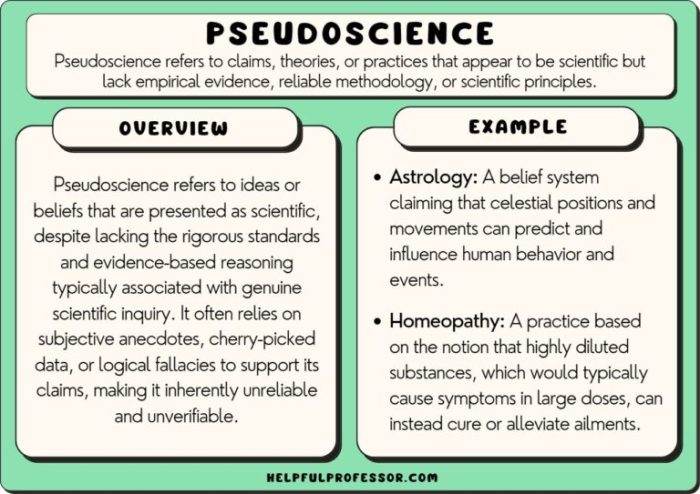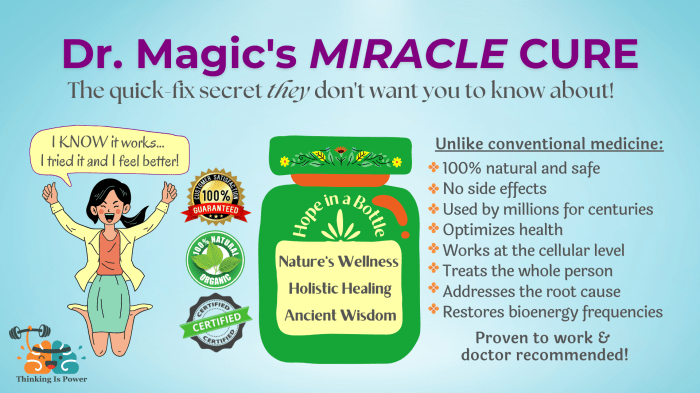Examples of pseudoscience in advertising – In the realm of advertising, examples of pseudoscience have become increasingly prevalent, employing deceptive tactics to sway consumer choices. This analysis delves into the definition, types, and consequences of pseudoscience in advertising, providing critical insights for discerning consumers.
Pseudoscience, often masquerading as genuine science, lacks the rigor and evidence-based approach of true scientific inquiry. Its claims are often exaggerated, unsubstantiated, or even deliberately misleading, potentially leading to misguided consumer decisions and detrimental societal impacts.
Pseudoscience in Advertising: Definition and Overview
Pseudoscience in advertising refers to the use of claims or techniques that appear scientific but lack a sound scientific basis. It often involves the misuse or misrepresentation of scientific concepts, data, or methods to create an illusion of credibility and persuade consumers.
Key characteristics of pseudoscience include: reliance on anecdotal evidence, lack of rigorous testing or peer review, overgeneralization, and the use of vague or ambiguous language. Pseudoscience is prevalent in advertising, particularly in industries such as health, beauty, and wellness, where consumers may be more vulnerable to misleading claims.
Types of Pseudoscientific Claims in Advertising
Common types of pseudoscientific claims in advertising include:
- Health claimsthat make exaggerated or unsubstantiated promises about the effectiveness of a product or treatment.
- Scientific jargonthat is used to create an impression of expertise but is actually meaningless or inaccurate.
- Testimonialsfrom individuals who claim to have experienced positive results, but whose credibility is not established.
- Appeals to emotionthat bypass rational thinking and play on consumers’ fears or desires.
Methods for Detecting Pseudoscience in Advertising

Consumers can identify pseudoscience in advertising by applying principles of critical thinking:
- Evaluate the source: Consider the credibility of the advertiser and whether they have a vested interest in promoting the product.
- Examine the evidence: Look for specific, verifiable evidence to support the claims being made.
- Be skeptical of extreme claims: Extraordinary claims require extraordinary evidence.
- Check for logical fallacies: Identify any unsupported assumptions or faulty reasoning in the advertising.
Consequences of Pseudoscience in Advertising: Examples Of Pseudoscience In Advertising

Pseudoscience in advertising has negative consequences for consumers, businesses, and society:
- Misleads consumers: Pseudoscience can lead consumers to make poor decisions about their health, finances, and well-being.
- Undermines trust: Misleading advertising erodes trust in businesses and the advertising industry.
- Harms public health: Pseudoscientific claims can promote ineffective or even harmful products or treatments.
Regulation and Ethical Considerations

Government agencies and industry self-regulation play a role in combating pseudoscience in advertising:
- Government agencies: Regulators can enforce laws against false or deceptive advertising.
- Industry self-regulation: Advertisers and marketers have ethical responsibilities to avoid misleading or deceptive claims.
Educating Consumers about Pseudoscience

Educating consumers about pseudoscience is crucial:
- Teach critical thinking skills: Empower consumers to evaluate advertising claims and make informed decisions.
- Provide resources: Create resources and initiatives that raise awareness about pseudoscience.
- Promote skepticism: Encourage consumers to question claims and seek reliable information before making purchases.
Helpful Answers
What are the key characteristics that distinguish pseudoscience from genuine science?
Pseudoscience lacks empirical evidence, relies on anecdotal claims, and often employs emotional appeals rather than logical reasoning.
How can consumers detect pseudoscience in advertising?
Consumers can evaluate claims critically by seeking scientific evidence, examining the source’s credibility, and being aware of common pseudoscientific tactics.
What are the consequences of pseudoscience in advertising for society?
Pseudoscience can undermine public trust in science, promote harmful practices, and hinder progress in addressing genuine health and environmental concerns.